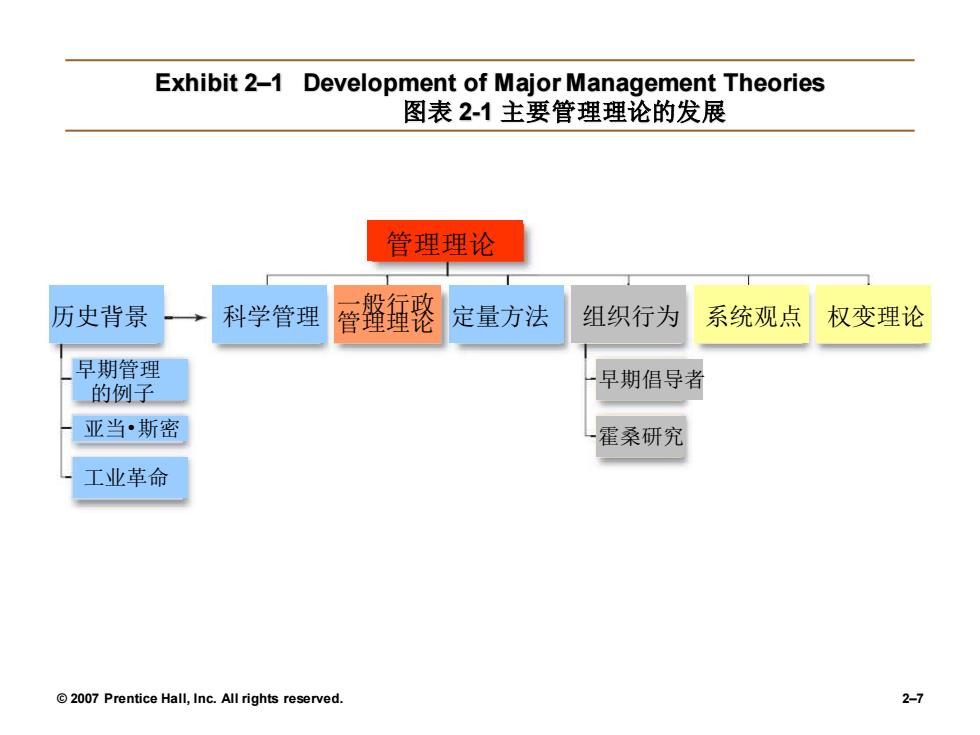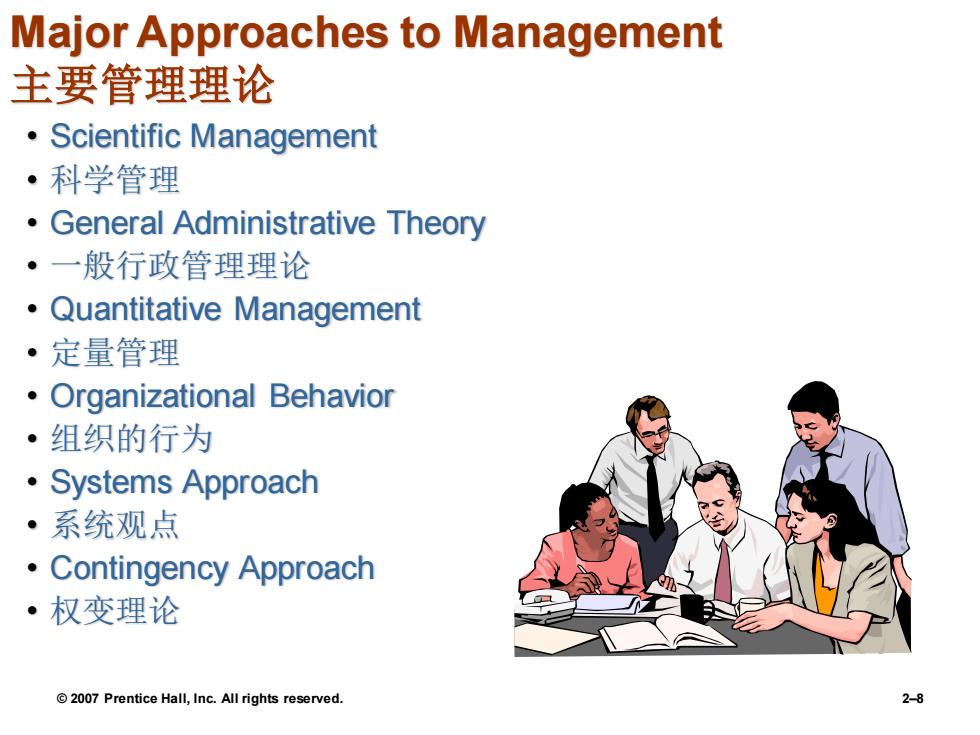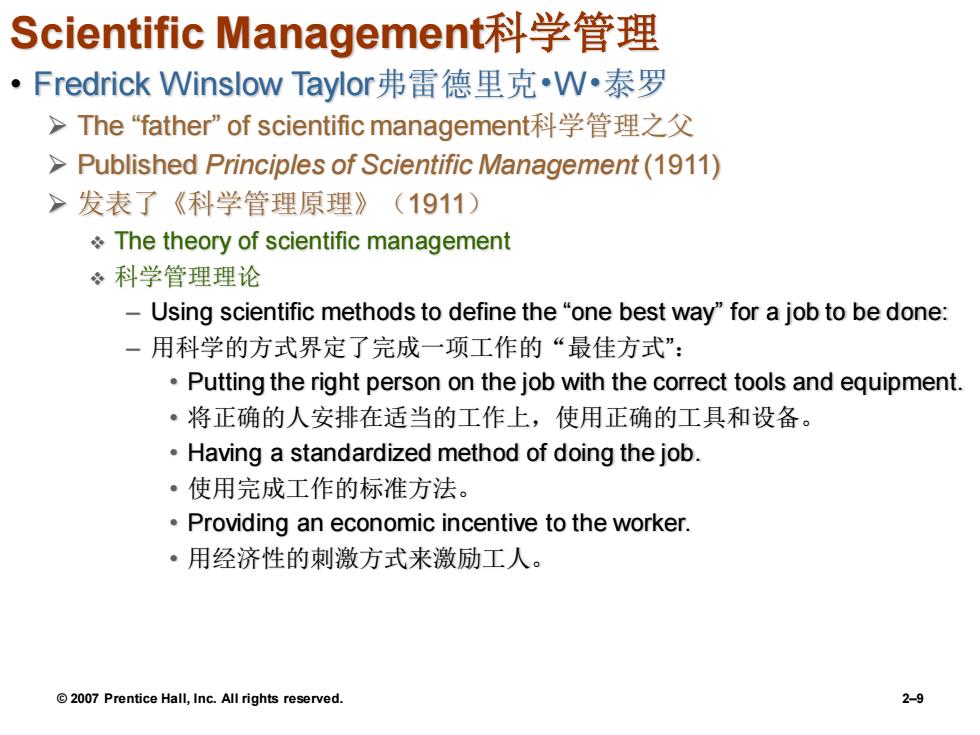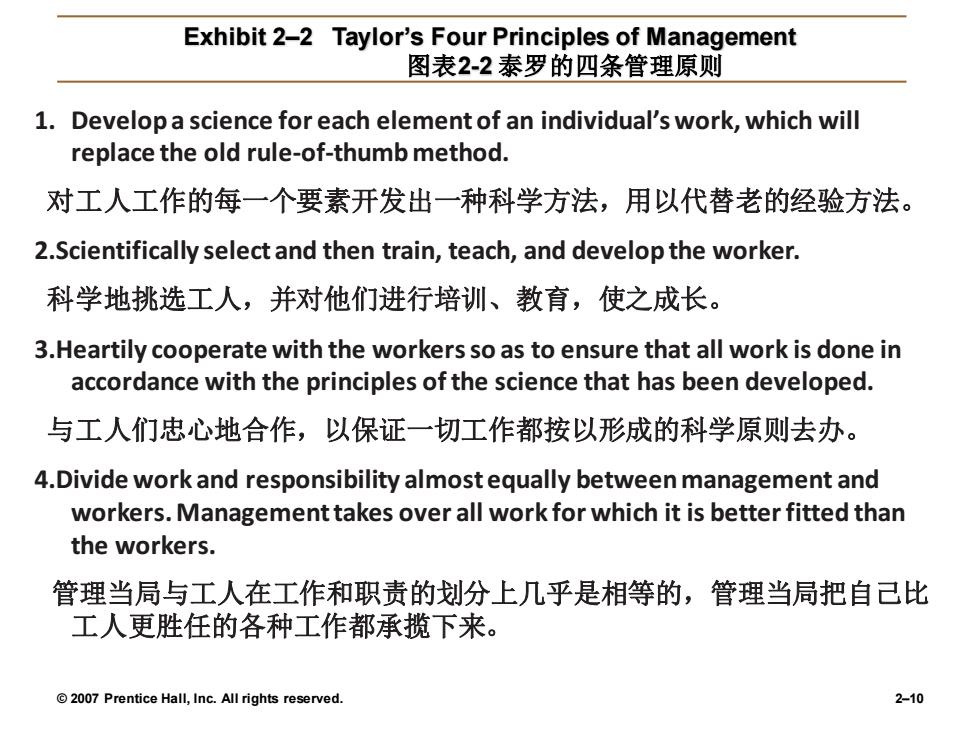
Historical Background of Management 管理的历史背景 ·Ancient Management早期管理 >Egypt(pyramids)and China(Great Wall) >埃及(金字塔)和中国(长城) Venetians (floating warship assembly lines) >威尼斯(战舰沿着运河移动) ·Adam Smith亚当·斯密 >Published "The Wealth of Nations"in 1776 >1776年发表了《国富论》 Advocated the division of labor (job specialization)to increase the productivity of workers 。主张以劳动分工(工作专业化)提高工人的生产率 ·Industrial Revolution.工业革命 >Substituted machine power for human labor >机械力代替了人力 >Created large organizations in need of management >使大组织产生了对管理理论的需求 2007 Prentice Hall,Inc.All rights reserved. 2-6
© 2007 Prentice Hall, Inc. All rights reserved. 2–6 Historical Background of Management 管理的历史背景 • Ancient Management早期管理 ➢ Egypt (pyramids) and China (Great Wall) ➢ 埃及(金字塔)和中国(长城) ➢ Venetians (floating warship assembly lines) ➢ 威尼斯(战舰沿着运河移动) • Adam Smith亚当•斯密 ➢ Published “The Wealth of Nations” in 1776 ➢ 1776年发表了《国富论》 ❖ Advocated the division of labor (job specialization) to increase the productivity of workers ❖ 主张以劳动分工(工作专业化)提高工人的生产率 • Industrial Revolution工业革命 ➢ Substituted machine power for human labor ➢ 机械力代替了人力 ➢ Created large organizations in need of management ➢ 使大组织产生了对管理理论的需求

Exhibit 2-1 Development of Major Management Theories 图表21主要管理理论的发展 管理理论 历史背景 科学管理 管鞶缍坠 定量方法 组织行为 系统观点 权变理论 早期管理 的例子 早期倡导者 亚当·斯密 霍桑研究 工业革命 2007 Prentice Hall,Inc.All rights reserved. 2-7
© 2007 Prentice Hall, Inc. All rights reserved. 2–7 Exhibit 2–1 Development of Major Management Theories 图表 2-1 主要管理理论的发展 管理理论 历史背景 早期管理 的例子 科学管理 一般行政 管理理论 定量方法 组织行为 系统观点 权变理论 亚当•斯密 工业革命 早期倡导者 霍桑研究

Major Approaches to Management 主要管理理论 Scientific Management ·科学管理 General Administrative Theory ·一般行政管理理论 Quantitative Management ·定量管理 Organizational Behavior ·组织的行为 ·Systems Approach ·系统观点 Contingency Approach ·权变理论 2007 Prentice Hall,Inc.All rights reserved. 2-8
© 2007 Prentice Hall, Inc. All rights reserved. 2–8 Major Approaches to Management 主要管理理论 • Scientific Management • 科学管理 • General Administrative Theory • 一般行政管理理论 • Quantitative Management • 定量管理 • Organizational Behavior • 组织的行为 • Systems Approach • 系统观点 • Contingency Approach • 权变理论

Scientific Management科学管理 ·Fredrick Winslow Taylor弗雷德里克W泰罗 >The“father'”of scientific management科学管理之父 >Published Principles of Scientific Management(1911) >发表了《科学管理原理》(1911) The theory of scientific management 冬科学管理理论 -Using scientific methods to define the"one best way"for a job to be done: 一用科学的方式界定了完成一项工作的“最佳方式”: Putting the right person on the job with the correct tools and equipment. ·将正确的人安排在适当的工作上,使用正确的工具和设备。 Having a standardized method of doing the job ·使用完成工作的标准方法。 Providing an economic incentive to the worker. ·用经济性的刺激方式来激励工人。 2007 Prentice Hall,Inc.All rights reserved
© 2007 Prentice Hall, Inc. All rights reserved. 2–9 Scientific Management科学管理 • Fredrick Winslow Taylor弗雷德里克•W•泰罗 ➢ The “father” of scientific management科学管理之父 ➢ Published Principles of Scientific Management (1911) ➢ 发表了《科学管理原理》(1911) ❖ The theory of scientific management ❖ 科学管理理论 – Using scientific methods to define the “one best way” for a job to be done: – 用科学的方式界定了完成一项工作的“最佳方式”: • Putting the right person on the job with the correct tools and equipment. • 将正确的人安排在适当的工作上,使用正确的工具和设备。 • Having a standardized method of doing the job. • 使用完成工作的标准方法。 • Providing an economic incentive to the worker. • 用经济性的刺激方式来激励工人

Exhibit 2-2 Taylor's Four Principles of Management 图表22泰罗的四条管理原则 1.Develop a science for each element of an individual's work,which will replace the old rule-of-thumb method. 对工人工作的每一个要素开发出一种科学方法,用以代替老的经验方法。 2.Scientifically select and then train,teach,and develop the worker. 科学地挑选工人,并对他们进行培训、教育,使之成长。 3.Heartily cooperate with the workers so as to ensure that all work is done in accordance with the principles of the science that has been developed. 与工人们忠心地合作,以保证一切工作都按以形成的科学原则去办。 4.Divide work and responsibility almost equally between management and workers.Management takes over all work for which it is better fitted than the workers. 管理当局与工人在工作和职责的划分上几乎是相等的,管理当局把自己比 工人更胜任的各种工作都承揽下来。 2007 Prentice Hall,Inc.All rights reserved. 2-10
© 2007 Prentice Hall, Inc. All rights reserved. 2–10 Exhibit 2–2 Taylor’s Four Principles of Management 图表2-2 泰罗的四条管理原则 1. Develop a science for each element of an individual’s work, which will replace the old rule-of-thumb method. 对工人工作的每一个要素开发出一种科学方法,用以代替老的经验方法。 2.Scientifically select and then train, teach, and develop the worker. 科学地挑选工人,并对他们进行培训、教育,使之成长。 3.Heartily cooperate with the workers so as to ensure that all work is done in accordance with the principles of the science that has been developed. 与工人们忠心地合作,以保证一切工作都按以形成的科学原则去办。 4.Divide work and responsibility almost equally between management and workers. Management takes over all work for which it is better fitted than the workers. 管理当局与工人在工作和职责的划分上几乎是相等的,管理当局把自己比 工人更胜任的各种工作都承揽下来